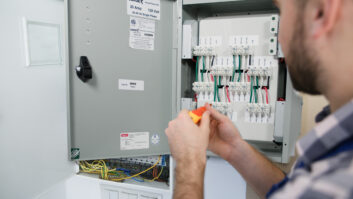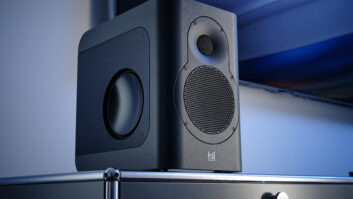This Integration Guide to Wireless Audio was sponsored by Atlona, Channel Vision, Gefen, and Sonos as a supplement to Residential Systems, September, 2012.


The Navvo Group, creator of a line of voice-controlled products housed under the VOCO umbrella, will release three new products this fall—all capable of streaming audio, with two of the three streaming both audio and video.
Just a few short years ago, wireless audio was a problematic, though highly desirable feature of home entertainment systems. Beset by interference and signal delivery issues, wireless audio distribution became an improvement project underpinned by evolving technologies, including Zigbee and Bluetooth, as well as proprietary ecosystems such as Apple’s AirPort. With the rapid adoption and stability improvements of WLAN and Wi-Fi, wireless audio has become a crystal-clear proposition for custom integrators seeking to outfit their installations with the best wireless audio systems that incorporate the latest, problem-free technologies, proprietary and otherwise— a value add-on that works equally well in new build and retrofit projects.


Smart devices play a key role in Pioneer Electronics’ wireless audio offerings, with the company introducing a slew of AV receivers (among them the VSX-42 and VSX-60 Elite receivers) with wireless music and control features, including streaming from Bluetooth-enabled devices to the receivers.
The Latest Products
Armed with customer feedback generated during the recent economic downturn, Proficient Audio is looking to integrate reliable wireless technologies into its cache of audio products. The resulting products, including Proficient Zero and the MaxTV Speaker, utilize Bluetooth technology for local access to music and audio from smartphones, tablets, and PCs.
“Our [integrators] told us that retrofit was the largest growth area for them,” noted Loren Maldoon, national sales manager for the company. “They were looking for ways to show their customers how they could expand their listening areas without having to take a second mortgage, which they couldn’t get anyway. The solution for us was easy integration using wireless products like AirFlex. These were well received in the market. Listening to feedback from integrators it evolved into Proficient Zero for multi-room.”
Recognizing that sources of wireless content have significantly expanded with the introduction cloud-based and internet audio sources, Aperion Audio has developed the ARIS wireless speaker system, which features a “plug-in networking card that lets the user select their network, and uses accepted standards for media distribution like DLNA, so that consumers can include all of their devices in their media experience,” said Mike Hopkins, Aperion Audio’s product development manager.
“The most important wireless audio features for our integrators are simplicity of setup, low latency, and signal reliability,’ Hopkins added. “Once our integrator partners experience our wireless products and are comfortable with the audio performance and reliability of the wireless system, we typically are asked about having the ability to customize the sound, since most of the powered systems incorporate some form of DSP, which is something we will consider integrating in the future.”
At CEDIA EXPO this month, Paradigm Electronics will unveil its new Aera AirPlay speaker system and Soundtrack system soundbar as components in its Shift Series, two products that illustrate the company’s expansion into wireless audio.
We are at the point in our industry where there are solutions that can legitimately claim 24bit/96KHz transmission or full HD video—a far cry from the old 900MHz speakers in your neighbor’s backyard,” said Mark Aling, senior marketing director for Paradigm. “Wireless transmission will always have naysayers, but it does not carry the stigma that it once did. AirPlay has certainly provided a “turbo boost” to the wireless world; however, one of the greatest influences has been broad consumer and installer acceptance of wireless transmission as a means of sending data and content from point A to B. Wi-Fi and Bluetooth are prime examples of that acceptance: Consumers use them every day without a second thought. The convenience of wireless has always been the killer app, and now the technology to fully realize that feature is catching up.”
Using the home’s wireless network, Legrand’s new lyriQ airQast source component is a blend of wire and wireless technologies that allow users to access, control, and play digital music from smart devices such as phones and tablets. The company also offers airQast bookshelf speakers for a standalone wireless music experience, with a free app that adjusts the system volume, build playlists, and streams music from services such as Pandora and XM/Sirius.
“Smart devices (i.e. phones, tablets) are a major component of the audio rebirth we are experiencing today,” said Fritz Werder, VP and general manager for Legrand On-Q. “Due to the portable nature of these devices, their ability to deliver quality audio and the fact that they live on wireless networks has created expectations from the users to extend these devices to players or renderers. Consumers have always desired wireless technology but there weren’t many options before.”
Smart devices also play a key role in Pioneer Electronics’ wireless audio offerings, with the company introducing a slew of AV receivers (among them the VSX-42 and VSX-60 Elite receivers) with wireless music and control features, including streaming from Bluetooth-enabled devices to the receivers, Apple AirPlay integration for streaming of iTunes libraries, and the company’s ControlApp & iControlAV2012 App, which gives users control of their receivers and home theater settings from the convenience of their iPad, iPhone, or iPod touch.
“With the growth of smartphone and tablets, consumers now live a connected lifestyle and they want to be connected regardless of where they are or what they’re doing,” said Chris Walker, director of AV marketing and product development for Pioneer’s Home Electronics division. “Smart devices are increasingly becoming the main sources of consumers’ music and entertainment, and this influences how consumers interact with their technology.”
Citing WASP Audio Technologies’ philosophy “to create uncompromised universal wireless products for the custom integrator,” founder and CEO David Tschirpke points to the company’s latest patent-pending product: LINK-Mount 2.1 system, which employs all the benefits of multiple band wireless technology in one easy-to-install system.
Tschirpke explained further: “As every installation is different based on environment, WASP LINK-Mount 2.1 System was designed so the custom integrator could select which frequency would work best depending on installation environment. Current LINK-Mount 2.1 systems work in the 2.4GHZ, 5.2GHz, and 5.8GHz ISM bands. To further enhance system flexibility, multiple LINK-Mount systems can be used in the same environment and use state-of-the-art Class D mono-block amplifiers.”
The Navvo Group, creator of a line of voice-controlled products housed under the VOCO umbrella, will release three new products this fall—all capable of streaming audio, with two of the three streaming both audio and video. Of these products, market and sales director Matthew Juaire pointed to the V-Spot, an all-in-one media system that has its own music server for local music as well as the ability to stream online content and play it through a five-speaker, five-driver array.
“Wireless Audio is a huge space and the data shows its importance,” said Juaire. The evolution of wireless audio, though, is taking us into video. YouTube in America shows that 31 percent of people using the service are streaming music videos; this is a perfect bridge into streaming video as a whole. Now you can watch YouTube videos up to 1080p on your TV through our VOCO Products.”
Known for the Sonnet, Mozaex has redesigned these wireless multi-room audio players to be fully compatible with non-Apple music, online media, and iTunes. Noting that the Sonnet is the world’s first and only audio player to support not only MP3s and online radio stations including Pandora, but also complete integration with the online iTunes store and the playback of iTunes music, CEO Douglas Kihm also explained that the Sonnet “may be uniquely controlled by Apple’s own Remote app on the iPhone, iPad, and other iDevices. Unlike AppleTV, with the Mozaex Sonnet, there is no limit to how many rooms you can have playing unique music.”

At CEDIA EXPO this month, Paradigm Electronics will unveil its new Aera Airplay speaker system and Soundtrack system soundbar as components in its Shift Series, two products that illustrate the company’s expansion into wireless audio.
With the addition of frequency-hopping technology to its WA-320 wireless audio transmitter and WA-350 1-to-1 wireless receiver and in-wall 100W class D amplifier, Channel Vision has been able to “maintain a high-quality signal and change channels to avoid interference of Wi-Fi signals from surrounding neighbors or internally within a home,” said Darrel Hauk, president and CEO.
“Demand of wireless in a home has become significant from anyone involved with the retrofit business,” Hauk added. “Many times running wires isn’t an option due to the complexity. Wireless home theater rear speakers and subwoofers have allowed additional revenues when installation cost exceeds the homeowners budget.”
Speaker manufacturer Sunfire recently debuted the Universal Wireless Subwoofer Kit to make the placement of a subwoofer just a little easier. Comprised of a receiver (SDSWIRX) and transmitter (SDSWITX), the kit is compatible with any third-party manufacturer’s powered subwoofer and allows consumers to place a subwoofer near any electrical outlet, up to 25 feet from the audio source, enabling optimal placement in most rooms. One transmitter can support two receivers for two separate subwoofers.
Speaking of subwoofers, Sonos will be unveiling its blackmatte SUB at this month’s CEDIA. The wireless subwoofer requires no programming and features a one-button press and prompt setup, with automatic adjustments of audio settings to balance the sub and its paired Sonos component. Its versatile positioning, whether vertically, horizontally, or flat under furniture, opens up several location possibilities. The SUB will be compatible with Sonos’ family of amplified components, including the company’s ZonePlayers.
Uniquely, CasaTunes develops software and hardware devices that allow users to control and listen to PC-based music throughout the home. Until recently, the company has been focused on wired multi-room audio, but its new CasaTunes Air, introduced in the CasaTunes release 4.0, has changed that. This new product adds two important wireless features, as outlined by Kim Knapp, CasaTunes co-founder. The first is the ability to create additional rooms using wireless AirPlay speakers, AVRs, and other AirPlay devices. The second is the ability to play music from any iOS device or iTunes, on a Mac or PC, wirelessly to CasaTunes rooms, the significance of which is the ability to play more than one stream at a time.
“We are hearing that our integrators particularly like the fact that their customers can now play music from any music service app that is available on an iPhone or iPad,” noted Knapp, “through the CasaTunes music server to wired and wireless rooms. As long as there is an app for it, it works.”
Based in Brooklyn, NY, Llanor Alleyne is a contributing editor to Residential Systems.
Bill Reynolds

Audio/Video Awakenings, Beaverton, OR
What features have helped you pitch wireless audio to you clients?
We have enjoyed being able to offer high-quality wireless speaker solutions in areas such as outside on patios where wiring isn’t possible, or in the case of commercial (MDU) residences, through wall where wiring isn’t allowed. The Aperion Zona wireless speaker system is a great, inexpensive choice that we have added to distributed audio installations on a few occasions. The system offers an affordable, high quality speaker system while providing a solution to a common obstacle.
Craig Cooley

Home Smart Home Inc., Plainville, MA
What features have helped you pitch wireless audio to you clients?
With the ability to play any Airplay source from an iPad, iPhone, or iPod touch it just gives the [CasaTunes] system so much more capability. Once the customer gets a chance to interact with the interface and they see how easy it is to use, they are instantly hooked. I had one customer see it working on my iPad and said, “I want that…How soon can I get it? I don’t care how much it costs.” That’s the kind of reaction I’ve been getting from virtually everyone I show it to. I think one of the coolest things, is the ability to create additional zones using some of the AirPlay devices. It’s seamless.
Michael Simmons

Inphase, Santa Clarita, CA
What features have helped you pitch wireless audio to your clients?
I’ve been using the Proficient AirFlex wireless audio products and the stuff makes it real easy to do retrofit of effects channels for surround. The customer doesn’t have to face the challenges of having us retro wire from one end of the room to the other. Another nice benefit is the room can be rearranged or the system can move to another room or another house without abandoning speakers and wire. The other strong feature is the reliability of signal quality. Both my customers and I find the performance better than expected.
James Lackey
Natural Sound Inc., Framingham, MA
What features or functions would you like to see in future iterations of wireless audio?
As a custom integrator of premium electronic components, we would want to have wireless products that could transmit the highest sampling and bit rates as possible without compression. We would also like these products to be able to send this signal throughout a home without interference from other wireless devices. Increasing range would ultimately allow us to offer wireless products on par with wired products when wireless is the only answer for a given installation. Last, we would like to lose the power cable with the use of near-field inductive power/charging.
Rick Bronner

Century Stereo, San Jose, CA
What features have helped you pitch wireless audio to your clients?
Incorporating a wireless option into Paradigm’s already spectacular subwoofer line is a win for us. With the receiver unit actually built into the subwoofer and available in several sizes combined with the ability to have up to four subwoofers off Paradigm’s PT-2 transmitter, the performance of the system is not compromised because you decided to go wireless.






